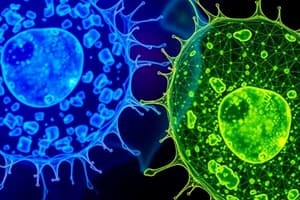Podcast
Questions and Answers
What are the key differences between prokaryotic and eukaryotic cells?
What are the key differences between prokaryotic and eukaryotic cells?
Prokaryotic cells lack a nucleus and membrane-bound organelles, while eukaryotic cells have a nucleus and distinct organelles.
Describe the process of mitosis and its significance in the cell cycle.
Describe the process of mitosis and its significance in the cell cycle.
Mitosis involves stages such as prophase, metaphase, anaphase, and telophase, leading to the division of one cell into two identical daughter cells.
Compare and contrast photosynthesis and cellular respiration in terms of their equations and locations.
Compare and contrast photosynthesis and cellular respiration in terms of their equations and locations.
Photosynthesis occurs in chloroplasts and can be summarized by the equation $6CO_2 + 6H_2O ightarrow C_6H_{12}O_6 + 6O_2$, while cellular respiration occurs in mitochondria with the equation $C_6H_{12}O_6 + 6O_2 ightarrow 6CO_2 + 6H_2O + ATP$.
What is the difference between benign and malignant tumors?
What is the difference between benign and malignant tumors?
What role do stem cells play in development and how do embryonic stem cells differ from tissue stem cells?
What role do stem cells play in development and how do embryonic stem cells differ from tissue stem cells?
Flashcards
Mitosis
Mitosis
A type of cell division where one parent cell divides into two identical daughter cells, ensuring the same number of chromosomes in each.
Cancer
Cancer
Uncontrolled cell growth and division, often leading to the formation of tumors. Can be benign (non-spreading) or malignant (spreading).
Stem Cells
Stem Cells
Undifferentiated cells capable of developing into various specialized cell types, with potential for regenerative medicine and treating diseases.
Cellular Respiration
Cellular Respiration
Signup and view all the flashcards
Photosynthesis
Photosynthesis
Signup and view all the flashcards
Study Notes
Diagrams
- animal/plant cell
- digestive system
- respiratory system
- heart
Topics
- prokaryotes/eukaryotes
- animal/plant cell parts and function
- diffusion/osmosis
- asexual vs. sexual reproduction
- cell theory
- cell cycle
- mitosis (stages)
- cancer (benign vs malignant, metastasis)
- specialized cells (animal vs plant hierarchy)
- stem cells (embryonic, tissue, pluripotent)
- digestive/respiratory/circulatory systems
- tissue types
- earthworm/frog dissections
- organ transplants
- musculoskeletal/nervous systems
- cellular respiration (equation, purpose, location)
- plant parts and function
- plant tissues
- photosynthesis (equation, purpose, location)
- stomata (function)
- photosynthesis vs. cellular respiration (comparison)
Questions
- #1-32, 35-37, 39, 41, 45, 48-50, 51, 53-55, 59, 60, 62, 65 (a-b), 66, 68, 77, 78
Test
- Friday, Dec 13th
Studying That Suits You
Use AI to generate personalized quizzes and flashcards to suit your learning preferences.




